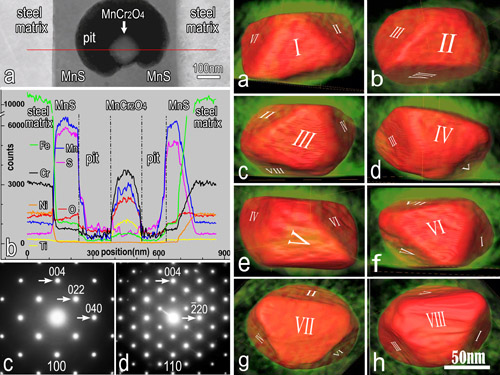Stainless steels are widely used in modern lifefor their superior corrosion resistance. However, stainless steels are actually not “stainless”; in the presence of aggressive anionic species they are susceptible to the localized pitting corrosion that is one of the major causes of materials’ failure and hence leads to a huge loss to our society. The pitting event is generally believed to originate from the local dissolution in MnS inclusions which are more or less ubiquitous in stainless steels. However, the initial location where MnS dissolution preferentially occurs is known as unpredictable, which makes pitting corrosion remain a big headache for stainless steels.
Recently, Professor MA Xiuliang and colleagues at Shenyang National Laboratory for Materials Science applied in-situex-environment transmission electron microscopy (TEM) and found a number of nano-sized octahedral MnCr2O4 crystals embedded in the MnS medium, generating local MnCr2O4/MnS nano-galvanic cells. The TEM experiments combined with first-principles calculations clarified that the nano-octahedron, enclosed by eight {111} facets with metal terminations, is “malignant”, which acts as the reactive site and catalyzes the dissolution of MnS. This study uncovers the origin of MnS dissolution in stainless steels and provides a new basis for understanding pitting corrosion of stainless steels. This work has been published recently in Acta Materialia (58, 5070-5085, (2010)).
So far, little attention has been paid to the ultra-fine inclusions in stainless steels, which is based on the cognization that they do not undermine the mechanical properties of the steels. However, the nano-sized oxide particles identified in the present study are found to play a critical chemical role in catalyzing MnS dissolution and pitting corrosion of the steels. The present findings are of great importance for steel-making industry by calling for the attention to nano-inclusions whose presence is neglected ordinarily. This work is expected to draw attention of material scientists,chemists, and biomedical workers to a general concern that the phenomena similar to the one in this study may occur in a wide range of engineering alloys and biomedical materials/instruments serving in wet environments.